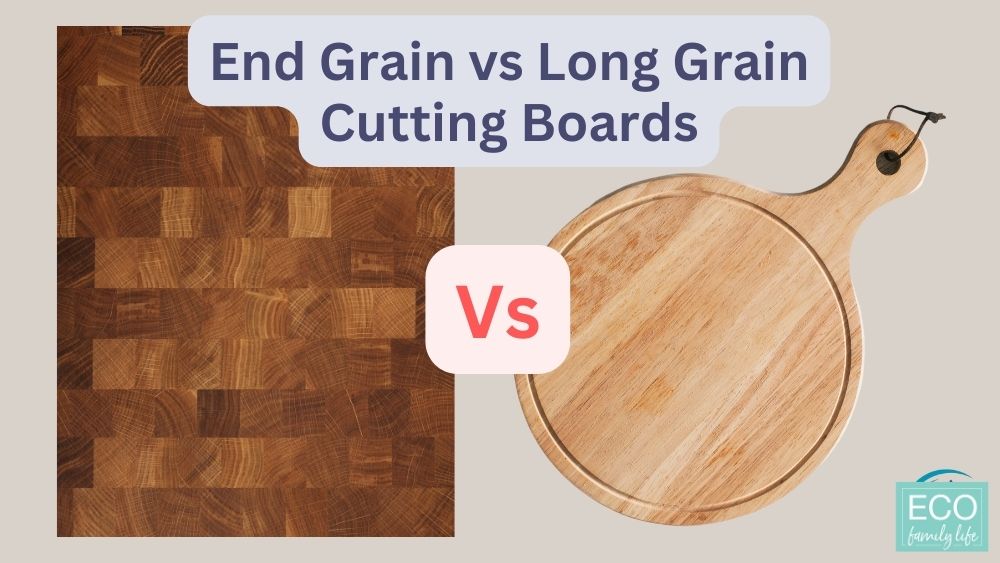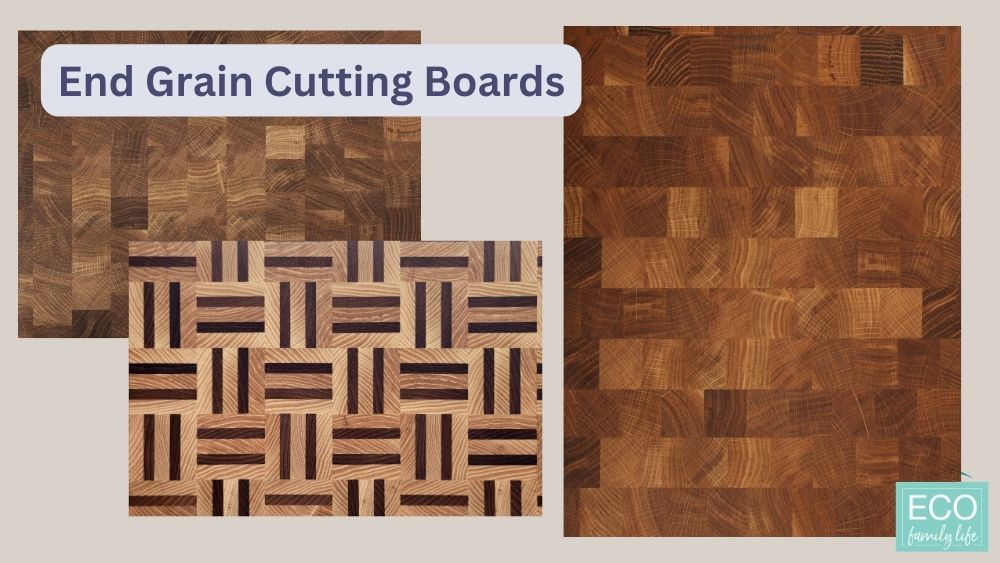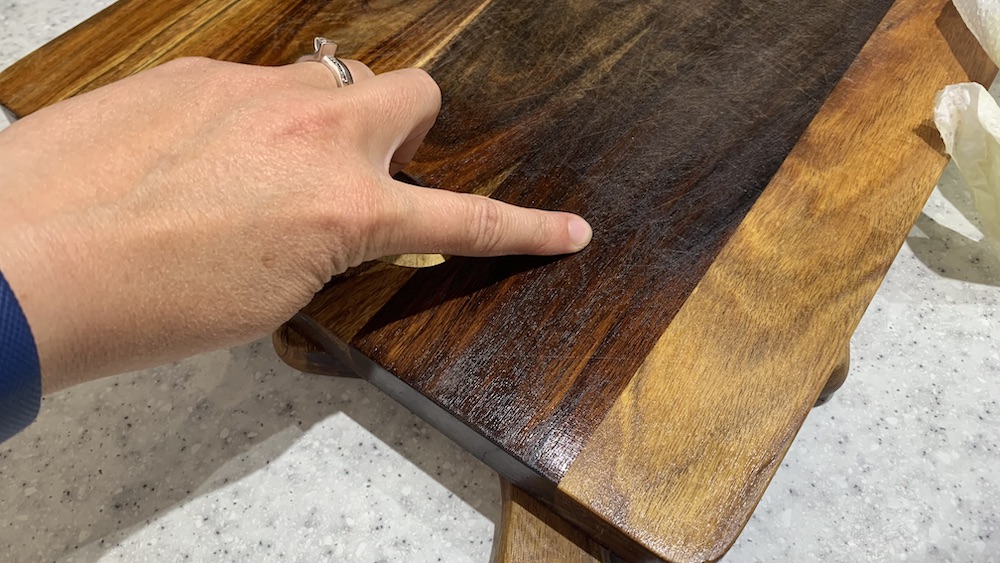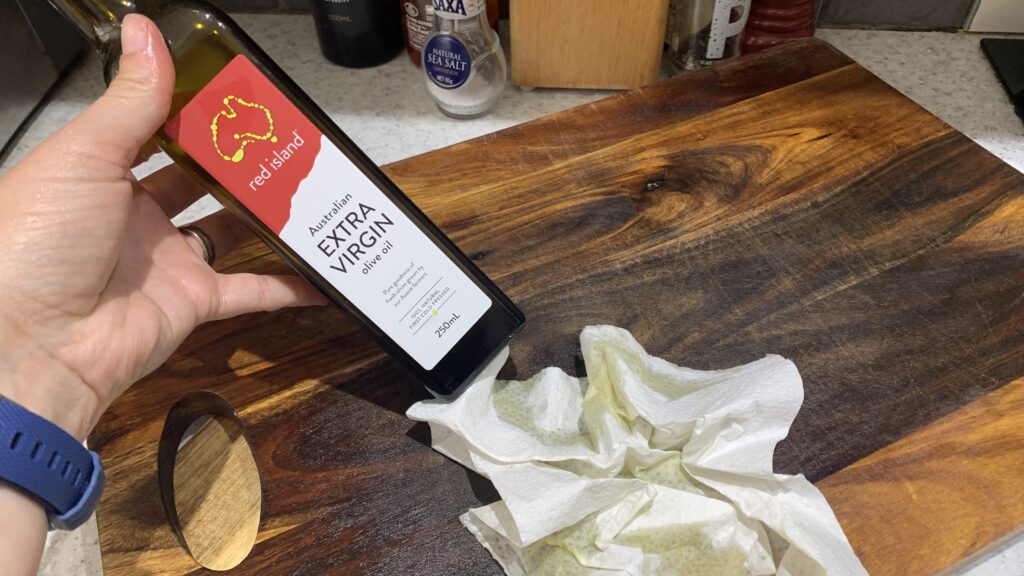End grain and long grain cutting boards have distinct differences. End grain boards are made by fusing wood fibers vertically, creating a more forgiving surface that’s gentle on knife blades. They’re excellent for heavy chopping and durability. Long grain boards have horizontal wood fibers, making them more affordable and suitable for everyday chopping. Choosing between them depends on your culinary needs and budget.

If you are looking for a new cutting board, this article will help you to understand the difference between the end and long grain options. In the next section, we’ll compare end grain and long grain cutting boards in more detail to help you make an informed decision.
Key Takeaways
- End grain cutting boards are more durable and knife-friendly, while long grain cutting boards are more affordable and forgiving with knives.
Understanding Cutting Boards
When it comes to wooden boards, there are two main types: end grain and long grain. Each type has its own advantages and disadvantages, and the choice between the two ultimately depends on your needs and preferences.
End Grain Cutting Boards
End grain cutting boards or “face grain” boards are made by cutting wood into small pieces and then gluing them together so that the wood grain faces up. This creates a surface that is very durable and resistant to knife marks. Because the knife cuts between the wood fibers instead of across them, end grain cutting boards are also gentler on knives and help to keep them sharp for longer.

You will be able to see the growth rings of the tree that the board was cut from which can make interesting and beautiful patterns. End grain cutting boards tend to be the most durable boards as they are thick, use strong wood and are glued in a way that will stop them from cracking. It is however essential that they get regular maintenance and are oiled often to avoid them drying out. If they are cared for they will last for a long time in your kitchen.
One downside to an end-grain board is that they can be more expensive than long grain boards. They also require more maintenance, as they need to be oiled regularly to prevent the wood from drying out and cracking.
Long Grain Cutting Boards
Long grain cutting boards are made by gluing together long strips of wood with the grain running parallel to the surface of the board. This creates a surface that is smooth and easy to clean. Long grain boards are also less expensive than end grain boards and require less maintenance.

One downside to long grain cutting boards is that they are more prone to knife marks and can dull knives more quickly than and edge-grain board. They are also more likely to warp or crack over time.
In summary, end grain cutting boards are more durable and gentler on knives, but require more maintenance and can be more expensive. Long grain cutting boards are less expensive and easier to maintain, but are more prone to cut marks and can dull knives more quickly. When choosing between the two, consider your needs and preferences to determine which type of cutting board is best for you.

Comparing End Grain and Long Grain Cutting Boards
End grain and long grain cutting boards both have their pros and cons. Check out this list before deciding which one is right for you.
Durability
End grain cutting boards are generally considered to be more durable than long grain cutting boards. This is because the fibers of the wood run vertically, which makes them less prone to knife marks and other damage. Additionally, end grain boards are more forgiving on your knives, as the fibers of the wood help to cushion the blade.
On the other hand, long grain cutting boards are still quite durable and can last for many years with proper care. They are also less expensive than end grain boards, which makes them a popular choice for home cooks on a budget.
Maintenance
Both end grain and long grain cutting boards require some maintenance to keep them in good condition. However, there are some differences to keep in mind.
End grain boards are more resistant to bacteria growth than long grain boards, as the fibers of the wood are less likely to trap moisture and food particles. However, they do require more frequent oiling to prevent the wood from drying out and cracking.

Long grain boards are easier to clean than end grain boards, as their flat surface makes it easier to wipe away debris. However, they are more prone to knife marks and other damage over time.
Price
End grain cutting boards are generally more expensive than long grain cutting boards. This is because they require more labor and materials to make, as the wood must be cut and arranged in a specific way to create the end grain pattern.
Long grain cutting boards, on the other hand, are more affordable and widely available. They are a great option for home cooks who want a durable and functional cutting board without breaking the bank.
In summary, both end grain and long grain cutting boards have their strengths and weaknesses. If you prioritize durability and don’t mind spending a bit more, an end grain board may be the way to go. However, if you’re on a budget or prefer a lower-maintenance option, a long grain board may be a better fit for your needs.
Impact on Knife Sharpness
When it comes to the impact on knife sharpness, end grain cutting boards are the clear winner. The end grain wood fibers will give under the weight of the blade having less impact on your knives. In contrast, long grain cutting boards are less forgiving with knives and will dull them more quickly. The grain runs side to side and therefore is harder on your knives.
End grain cutting boards also have reduced knife slippage compared to long grain cutting boards. The wood fibers naturally grip the knife edge, helping to prevent the knife from slipping during use. This not only helps to protect your fingers from accidental cuts but also helps to maintain the sharpness of your knives.
It’s important to note that while end grain cutting boards are gentler on your knives, they do require more maintenance than long grain cutting boards. They need to be oiled on a regular basis to prevent the wood from drying out and cracking. However, the extra maintenance is worth it if you want to keep your knives sharp for longer.
In summary, if you want to maintain the sharpness of your knives, an end grain cutting board is the way to go. They are more forgiving with knives and have reduced knife slippage, making them a safer and more efficient option for your kitchen. However, keep in mind that they do require more maintenance than long grain cutting boards.
Best Cutting Board for Different Cooking Needs
When it comes to choosing the best cutting board for your cooking needs, it’s important to consider the type of food you’ll be preparing. Here are some tips on selecting the right cutting board for different types of food:
Chopping Vegetables
If you’re mostly chopping vegetables, an end grain cutting board is a great choice. End grain boards are gentle on your knives, making them ideal for chopping and slicing. They are also more durable than long grain boards, so they won’t show wear and tear as easily. Additionally, end grain boards are better at absorbing moisture, which helps keep your vegetables from slipping around while you’re chopping.
Slicing Meat
For slicing meat, an end grain cutting board is generally a better choice. End grain boards have the wood fibers oriented vertically, which allows the knife blade to partially sink into the wood’s softer fibers. This minimizes the impact on the blade’s edge and helps retain its sharpness.
An end grain butcher block is a great option for cutting meat as they are typically made from dense hardwoods like maple or oak, which are exceptionally durable and can withstand heavy use and frequent chopping. Properly maintained butcher blocks are naturally resistant to bacteria and are less likely to harbor germs than plastic or other materials and they provide a stable surface for precise cuts and are less likely to move or slip during meat preparation.
Cutting Bread
If you’re cutting bread, the best cutting board is a long grain option like a bamboo cutting board. Bamboo cutting boards are eco-friendly and easy to clean, making them a great choice for any kitchen.
Overall, the best cutting board for your cooking needs depends on the type of food you’ll be preparing. Consider the above tips when selecting a cutting board and you’ll be sure to find one that meets your needs.
Conclusion
When it comes to choosing between an end grain and long grain cutting board, there is no clear winner. Both types of cutting boards have their own advantages and disadvantages, and the choice ultimately comes down to personal preference and intended use.
If you are looking for a cutting board that is durable and can withstand heavy use, an end grain cutting board may be the best choice for you. End grain boards are less likely to warp or crack over time and are more resistant to knife marks. They are also gentler on your knives, helping to keep them sharp for longer. They do tend to be heavier however and need regular oiling.
On the other hand, if you are on a budget or prefer a lighter weight cutting board, a long grain board may be a better option. Long grain boards are generally less expensive and easier to maneuver in the kitchen. They are also easier to maintain and do not require as much oiling as end grain boards.
Ultimately, the decision between end grain and long grain cutting boards comes down to your personal preferences and needs. Consider the type of cooking you do, your budget, and your storage space when choosing the right cutting board for you. Regardless of which type you choose, be sure to properly care for your cutting board to ensure it lasts for years to come.
Frequently Asked Questions
What are the advantages of using an end grain cutting board?
End grain cutting boards or edge grain boards are highly durable and resistant to knife marks. They are also gentle on your knives, so they won’t dull them as quickly. Additionally, they are more forgiving when it comes to chopping, making them ideal for chefs who chop a lot of vegetables.
What types of wood are best for end grain cutting boards?
Hardwoods such as maple, walnut, and cherry are ideal for end grain cutting boards because they are durable and have a tight grain pattern that resists knife marks.
What are the benefits of using a long grain cutting board?
Long grain cutting boards are generally more affordable than end grain cutting boards. They are also easier to maintain and less prone to warping. However, they are not as durable as end grain cutting boards and can dull your knives more quickly.
Is it safe to cut raw meat on an end grain cutting board?
Yes, it is safe to cut raw meat on an end grain cutting board. The tight grain pattern of the wood prevents bacteria from penetrating deep into the board, reducing the risk of cross-contamination.
What is the difference between end grain and long grain cutting boards?
End grain cutting boards are made by fusing together the ends of wood strips, creating a checkerboard pattern on the surface. Long grain cutting boards are made by gluing together long strips of wood. End grain boards are more durable and gentle on knives, while long grain boards are more affordable and easier to maintain.
What should I consider when choosing between an end grain and a long grain cutting board?
Consider your budget, how often you will use the board, and what you will be using it for. If you chop a lot of vegetables and want a board that will last for years, an end grain cutting board is a good investment. If you are on a tight budget or don’t chop a lot, a long grain cutting board may be a better option.
I am an accredited practicing dietitian, experienced gardener and a dedicated cook. I love writing and sharing my experience so you can learn from my successes and mistakes.
